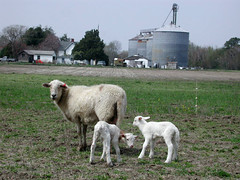 The majority of lamb deaths occur in the first three days after birth and range from 5 to 30% for individual sheep flocks. The ability of a lamb (or kid) to survive to weaning is related to genetics, behavior, physiology, and the environment, including on-farm management practices.
The majority of lamb deaths occur in the first three days after birth and range from 5 to 30% for individual sheep flocks. The ability of a lamb (or kid) to survive to weaning is related to genetics, behavior, physiology, and the environment, including on-farm management practices.The effects of dam body condition, condition in pregnancy, weather during lambing, lamb birth weight, and maternal behavior on single, twin, and triplet lamb viability, lamb death risks from dystocia and starvation exposure, and survival to weaning for 15,821 lambs born to twenty high-performing New Zealand flocks were recently published in the Journal of Animal Science.
Accoding to the data, lambs weighing 5.5 to 6 kg (12.1 to 13.2 lbs.) at birth were more likely to be viable at birth and survive to weaning than heavier or lighter lambs. The optimum birth weight for survival was 1 kg (2.2 lbs.) above the mean (4.8 kg/10.6 lbs.).
Lamb survival to weaning age was greatest for lambs born to dams of greater body condition score. Weather conditions during late pregnancy proved more important than conditions during lambing in determining lamb viability and survival through to weaning.
Older ewes and ewes with triplets require considerably more attention for farmers to realize their production potential. Ideally, ewes with triplets should be identified as early as possible, separated, and preferentially fed.
Read abstract from Journal of Animal Science, April 2008
